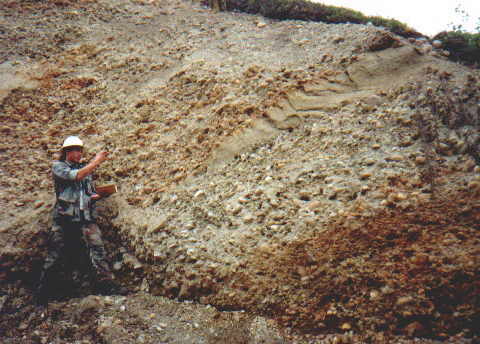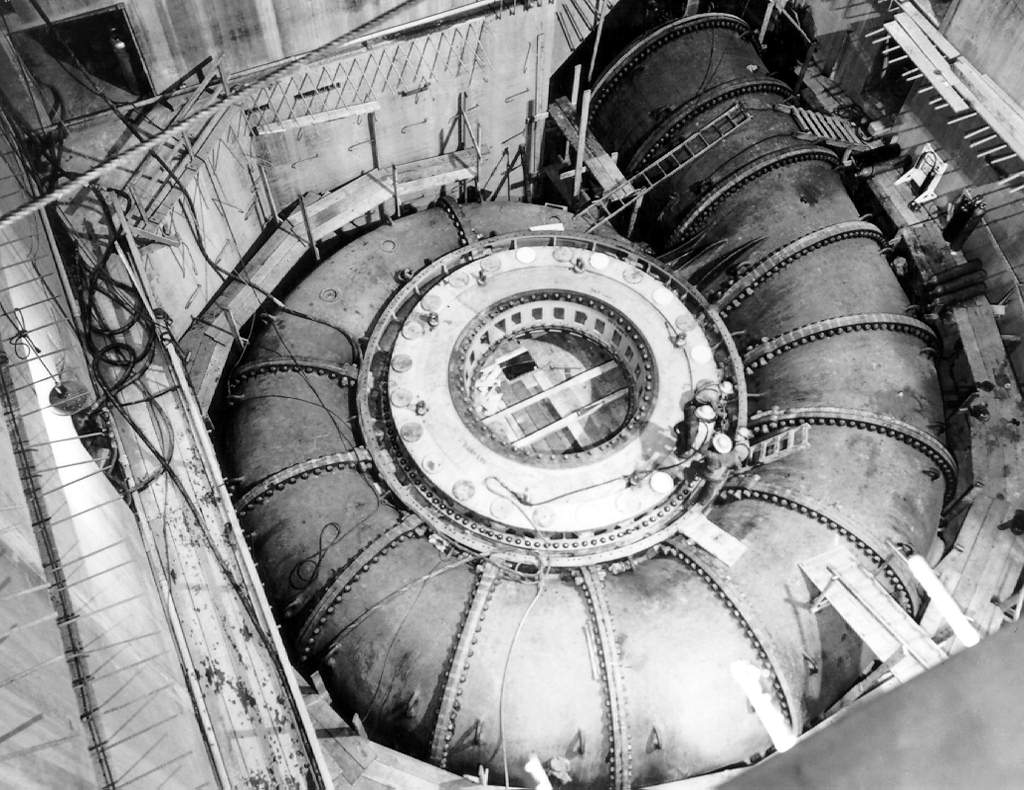|
Rangit Dam
Rangit Dam (Hindi: रन्गीत् बाँध Bāndh), which forms the headworks of the Rangit Hydroelectric Power Project Stage III, is a run-of-the-river power project on the Ranjit River, a major tributary of the Teesta River in the South Sikkim district of the Northeastern Indian state of Sikkim. The project's construction was completed in 1999. The project is fully functional since 2000. The project was built at a cost of Rs 4922.6 million (Rs 492.26 crores) (at US$1 = Rs 45, this is US$109.39 million). The average annual power generation from the 60 MW (3x20 MW) project is 340 GWh with firm power of 39 MW. Topography The Ranjit River on which the Rangit Dam is located, is a major right bank tributary of the Teesta River in Sikkim. The river arises from the Talung glacier and it meets the Teesta river at Melli after a travel of from its source. At the dam site, the catchment area drained is (rain-fed catchment is and the balance area is snow fed above snow lin ... [...More Info...] [...Related Items...] OR: [Wikipedia] [Google] [Baidu] |
Rangeet River
The Rangeet or Rangit is a tributary of the Teesta river, which is the largest river in the Indian state of Sikkim. The Rangeet river originates in the Himalayan mountains in West Sikkim district. The river also forms the boundary between Sikkim and Darjeeling district. A perennial river, it is fed by the melting snow of the Himalayas in early summer and the monsoon rains in June–September. It is popular among rafting enthusiasts owing to its turbulent waters. The river flows past the towns of Jorethang, Pelling and Legship. During its final few kilometres, it joins the Teesta River at a confluence known as Tribeni, which is a popular picnic spot. The Rangeet river has an NHPC hydropower Hydropower (from el, ὕδωρ, "water"), also known as water power, is the use of falling or fast-running water to produce electricity or to power machines. This is achieved by converting the gravitational potential or kinetic energy of ... plant with a capacity of capacity ... [...More Info...] [...Related Items...] OR: [Wikipedia] [Google] [Baidu] |
Alluvium
Alluvium (from Latin ''alluvius'', from ''alluere'' 'to wash against') is loose clay, silt, sand, or gravel that has been deposited by running water in a stream bed, on a floodplain, in an alluvial fan or beach, or in similar settings. Alluvium is also sometimes called alluvial deposit. Alluvium is typically geologically young and is not consolidated into solid rock. Sediments deposited underwater, in seas, estuaries, lakes, or ponds, are not described as alluvium. Floodplain alluvium can be highly fertile, and supported some of the earliest human civilizations. Definitions The present consensus is that "alluvium" refers to loose sediments of all types deposited by running water in floodplains or in alluvial fans or related landforms. However, the meaning of the term has varied considerably since it was first defined in the French dictionary of Antoine Furetière, posthumously published in 1690. Drawing upon concepts from Roman law, Furetière defined ''alluvion'' (the F ... [...More Info...] [...Related Items...] OR: [Wikipedia] [Google] [Baidu] |
Mixed Coniferous Forest
Mixed coniferous forest is a vegetation type dominated by a mixture of broadleaf trees and conifers.Sierra Nevada Wildflowers, Karen Wiese, 2nd ed, 2013, p 13–14 It is generally located in mountains, below the upper montane vegetation type. Sierra Nevada range In the Sierra Nevada mountain range of the western United States, the mixed coniferous forest is found at elevations of in the north, in central areas, and in the south. Characteristic conifers include Ponderosa Pine (''Pinus ponderosa''), Sugar Pine (''Pinus lambertiana''), Incense Cedar (''Calocedrus decurrens''), White Fir (''Abies concolor''), Douglas Fir (''Pseudotsuga menziesii''), and Giant Sequoias (''Sequoiadendron giganteum'') in pockets. Characteristic broadleaved trees include Black Oak ('' Quercus kelloggii''), and understory trees and shrubs, including Canyon Live Oak ('' Quercus chrysolepis''), Dogwood ( ''Cornus'' spp.), Mountain Misery ('' Chamaebatia foliolosa''), and Manzanitas ( ''Arctostaphylos'' s ... [...More Info...] [...Related Items...] OR: [Wikipedia] [Google] [Baidu] |
Rhododendron
''Rhododendron'' (; from Ancient Greek ''rhódon'' "rose" and ''déndron'' "tree") is a very large genus of about 1,024 species of woody plants in the heath family (Ericaceae). They can be either evergreen or deciduous. Most species are native to eastern Asia and the Himalayan region, but smaller numbers occur elsewhere in Asia, and in North America, Europe and Australia. It is the national flower of Nepal, the state flower of Washington and West Virginia in the United States, the state flower of Nagaland in India, the provincial flower of Jiangxi in China and the state tree of Sikkim and Uttarakhand in India. Most species have brightly colored flowers which bloom from late winter through to early summer. Azaleas make up two subgenera of ''Rhododendron''. They are distinguished from "true" rhododendrons by having only five anthers per flower. Species Description ''Rhododendron'' is a genus of shrubs and small to (rarely) large trees, the smallest species growing to ... [...More Info...] [...Related Items...] OR: [Wikipedia] [Google] [Baidu] |
Ministry Of Environment And Forests
The Ministry of Environment, Forest and Climate Change (MoEFCC) is an Indian government ministry. This ministry is headed by Secretary Rank senior most IAS officer. The ministry portfolio is currently held by Bhupender Yadav, Union Minister of Environment, Forest and Climate Change. The ministry is responsible for planning, promoting, coordinating, and overseeing the implementation of environmental and forestry programmes in the country. The main activities undertaken by the ministry include conservation and survey of the flora of India and fauna of India, forests and other wilderness areas; prevention and control of pollution; Indian Himalayan Environment and its sustainable development;afforestation, and land degradation mitigation. It is responsible for the administration of the 1947 national parks of India. The Ministry of Environment, Forest and Climate Change is the cadre controlling authority of the Indian Forest Service (IFS), one of the three All India Services. ... [...More Info...] [...Related Items...] OR: [Wikipedia] [Google] [Baidu] |
Central Water Commission
Central Water Commission (CWC) is a technical organisation that functions as part of the Ministry of Jal Shakti in the Government of India. They are entrusted with the responsibilities of providing consultation to various state governments on water bodies related issues, coordinate various governmental schemes for conservation, control, and utilisation of water resources. Central Water Commission help state governments in devising and analysing flood control Flood control methods are used to reduce or prevent the detrimental effects of flood waters."Flood Control", MSN Encarta, 2008 (see below: Further reading). Flood relief methods are used to reduce the effects of flood waters or high water level ... measures. They undertake flash flood forecast as well. Their professional assistance is received by the government for various irrigation and drinking water supply projects. Water Power Development is another area where central water commission undertakes the tasks of investigati ... [...More Info...] [...Related Items...] OR: [Wikipedia] [Google] [Baidu] |
Parastatal
A state-owned enterprise (SOE) is a government entity which is established or nationalised by the ''national government'' or ''provincial government'' by an executive order or an act of legislation in order to earn profit for the government, control monopoly of the private sector entities, provide products and services to citizens at a lower price and for the achievement of overall financial goals & developmental objectives in a particular country. The national government or provincial government has majority ownership over these ''state owned enterprises''. These ''state owned enterprises'' are also known as public sector undertakings in some countries. Defining characteristics of SOEs are their distinct legal form and possession of financial goals & developmental objectives (e.g., a state railway company may aim to make transportation more accessible and earn profit for the government), SOEs are government entities established to pursue financial objectives and devel ... [...More Info...] [...Related Items...] OR: [Wikipedia] [Google] [Baidu] |
Government Of India
The Government of India ( ISO: ; often abbreviated as GoI), known as the Union Government or Central Government but often simply as the Centre, is the national government of the Republic of India, a federal democracy located in South Asia, consisting of 28 union states and eight union territories. Under the Constitution, there are three primary branches of government: the legislative, the executive and the judiciary, whose powers are vested in a bicameral Parliament, President, aided by the Council of Ministers, and the Supreme Court respectively. Through judicial evolution, the Parliament has lost its sovereignty as its amendments to the Constitution are subject to judicial intervention. Judicial appointments in India are unique in that the executive or legislature have negligible say. Etymology and history The Government of India Act 1833, passed by the British parliament, is the first such act of law with the epithet "Government of India". Basic structure The ... [...More Info...] [...Related Items...] OR: [Wikipedia] [Google] [Baidu] |
Francis Turbine
The Francis turbine is a type of water turbine. It is an inward-flow reaction turbine that combines Radial turbine, radial and Axial flow turbine, axial flow concepts. Francis turbines are the most common water turbine in use today, and can achieve over 95% efficiency. The process of arriving at the modern Francis runner design took from 1848 to approximately 1920. It became known as the Francis turbine around 1920, being named after British-American engineer James B. Francis who in 1848 created a new turbine design. Francis turbines are primarily used for producing electricity. The power output of the electric generators generally ranges from just a few kilowatts up to 1000 MW, though mini-hydro installations may be lower. The best performance is seen when the Hydraulic head, head height is between . Penstock diameters are between . The speeds of different turbine units range from 70 to 1000 rpm. A Wicket gate (hydraulics), wicket gate around the outside of the Water tur ... [...More Info...] [...Related Items...] OR: [Wikipedia] [Google] [Baidu] |
An Aerial View Rangit Dam & Reservoir On Rangit River
An, AN, aN, or an may refer to: Businesses and organizations * Airlinair (IATA airline code AN) * Alleanza Nazionale, a former political party in Italy * AnimeNEXT, an annual anime convention located in New Jersey * Anime North, a Canadian anime convention * Ansett Australia, a major Australian airline group that is now defunct (IATA designator AN) * Apalachicola Northern Railroad (reporting mark AN) 1903–2002 ** AN Railway, a successor company, 2002– * Aryan Nations, a white supremacist religious organization * Australian National Railways Commission, an Australian rail operator from 1975 until 1987 * Antonov, a Ukrainian (formerly Soviet) aircraft manufacturing and services company, as a model prefix Entertainment and media * Antv, an Indonesian television network * ''Astronomische Nachrichten'', or ''Astronomical Notes'', an international astronomy journal * ''Avisa Nordland'', a Norwegian newspaper * '' Sweet Bean'' (あん), a 2015 Japanese film also known as ''A ... [...More Info...] [...Related Items...] OR: [Wikipedia] [Google] [Baidu] |
Clay
Clay is a type of fine-grained natural soil material containing clay minerals (hydrous aluminium phyllosilicates, e.g. kaolin, Al2 Si2 O5( OH)4). Clays develop plasticity when wet, due to a molecular film of water surrounding the clay particles, but become hard, brittle and non–plastic upon drying or firing. Most pure clay minerals are white or light-coloured, but natural clays show a variety of colours from impurities, such as a reddish or brownish colour from small amounts of iron oxide. Clay is the oldest known ceramic material. Prehistoric humans discovered the useful properties of clay and used it for making pottery. Some of the earliest pottery shards have been dated to around 14,000 BC, and clay tablets were the first known writing medium. Clay is used in many modern industrial processes, such as paper making, cement production, and chemical filtering. Between one-half and two-thirds of the world's population live or work in buildings made with clay, ofte ... [...More Info...] [...Related Items...] OR: [Wikipedia] [Google] [Baidu] |




.jpg)

